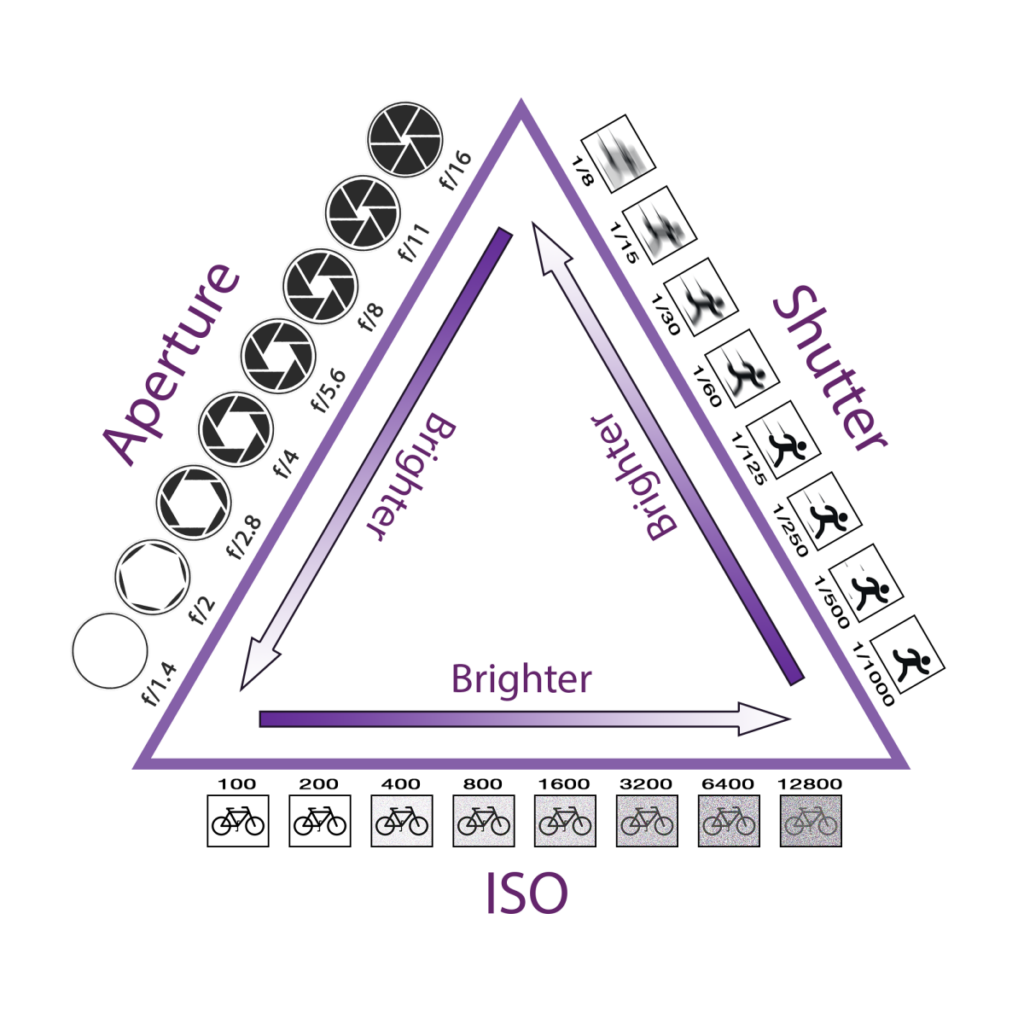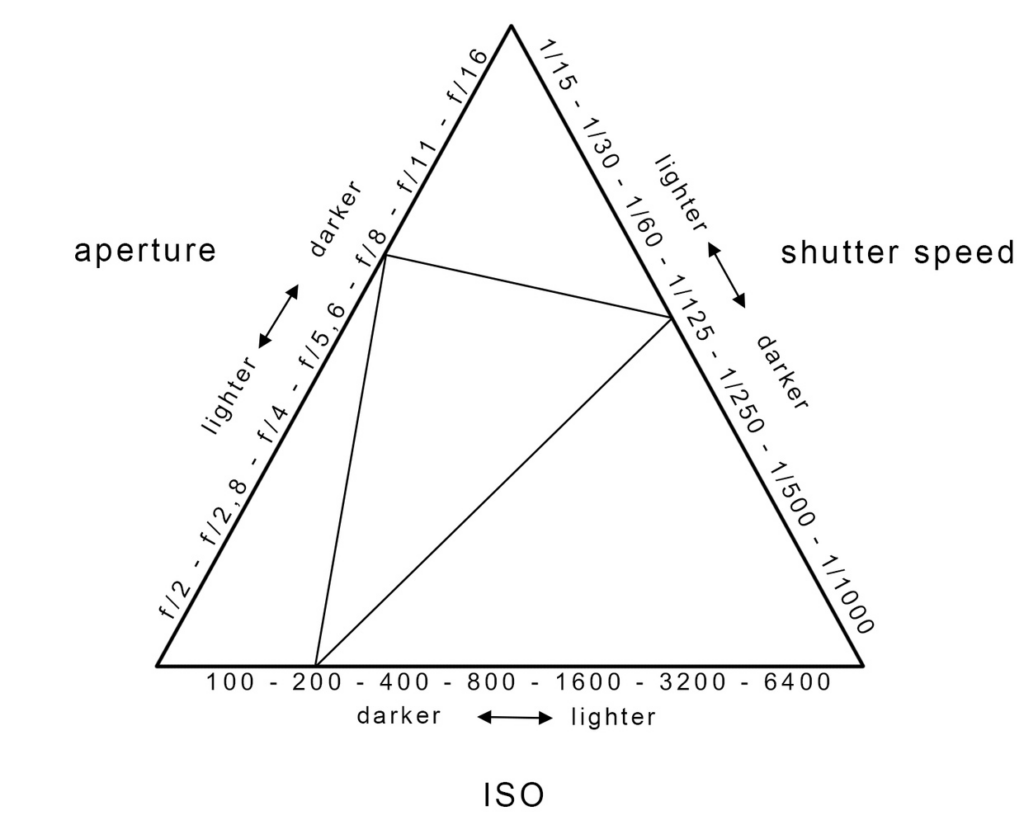Photography is essentially the art of capturing light. Whether you’re shooting breathtaking landscapes, intimate portraits, or fast-paced sports events, understanding how to control light is crucial to creating the images you envision. At the heart of this control lies the exposure triangle – a fundamental concept that every photographer must master.
The exposure triangle consists of three key settings: aperture, shutter speed, and ISO. These elements work together to determine the brightness and clarity of your photo. Adjusting one setting affects the others, so finding the right balance is essential. By mastering the exposure triangle, you gain full creative control over your images, allowing you to achieve the perfect exposure in any lighting condition.

What is the Exposure Triangle?
The exposure triangle consists of three essential elements that work together to create a properly exposed photograph: aperture, shutter speed, and ISO. Think of these as three interconnected controls, each affecting not only the amount of light captured but also bringing its own creative effects to your images.
Aperture controls the depth of field, influencing how much of the scene is in focus. Shutter speed determines how motion is captured, allowing you to freeze action or create a blur effect. ISO affects the sensitivity of your camera’s sensor to light, impacting image quality, especially in low-light situations. By understanding how each component interacts, you can experiment and achieve the perfect exposure for any scene or creative vision.
The Foundation: Understanding Light
Before diving into the three components, let’s briefly understand what we’re actually working with – light. Every photograph you take is essentially a recording of light reflecting off your subject and reaching your camera’s sensor (or film). This light can vary in:
- Intensity: How bright or dim the light source is
- Quality: Whether it’s harsh direct light or soft diffused light
- Direction: Where the light is coming from
- Color: The temperature and tint of the light
Your camera needs to capture this light in a way that creates a well-exposed image, and that’s where the exposure triangle comes into play. By adjusting the settings within the triangle, you control how much light reaches the sensor, how that light affects the mood, and how well details are captured. Mastering light and its characteristics allows you to take full creative control over your photos.
The Three Pillars of Exposure
1. Aperture: Controlling Light and Depth
Aperture is perhaps the most complex of the three elements, as it controls both the amount of light entering your camera and the depth of field in your image. Think of it as the iris of your camera’s eye – it can open wide to let in more light or close down to restrict light.
Aperture is measured in f-stops (like f/1.8, f/4, f/16), and counter-intuitively, the smaller the f-number, the larger the aperture opening. Here’s what aperture affects:
- Light Control: A wider aperture (smaller f-number) lets in more light, while a narrower aperture (larger f-number) restricts light, making it ideal for low-light environments.
- Depth of Field: Wide apertures create a shallow depth of field (less in focus), which is great for portraits or isolating subjects. Narrow apertures increase depth of field (more in focus), which is perfect for landscapes or architectural photography.
Additionally, aperture also influences the bokeh effect, which is the quality of the out-of-focus areas in an image. Larger apertures create a smoother, more aesthetically pleasing bokeh, while smaller apertures produce a more defined, busy background.
2. Shutter Speed: Time and Motion
Shutter speed is arguably the most straightforward of the three elements – it’s simply the length of time your camera’s sensor is exposed to light. Measured in fractions of a second (like 1/1000, 1/60, 1 second), shutter speed controls:
- Exposure Duration: Longer speeds let in more light, making them suitable for low-light conditions or night photography. Shorter speeds let in less light, preventing overexposure in bright conditions.
- Motion Capture: Fast speeds freeze motion, ideal for action shots, while slow speeds create motion blur, which can be used creatively to show movement (like a flowing waterfall or car lights at night).
- Camera Shake: Slower speeds are more susceptible to camera movement, requiring stabilization. Using a tripod or increasing shutter speed helps prevent blurry images caused by camera shake.
3. ISO: Light Sensitivity
ISO is your camera’s sensitivity to light, and it’s the only element that doesn’t physically control the light entering your camera. Instead, it adjusts how your camera’s sensor responds to that light. Higher ISO numbers (like 1600, 3200) make your sensor more sensitive to light, while lower numbers (like 100, 200) make it less sensitive.
However, ISO comes with a trade-off:
- Higher ISO values introduce more digital noise or grain, which can degrade image quality, especially in the shadows.
- Lower ISO values produce cleaner images but require more light, meaning you may need to compensate with wider apertures or slower shutter speeds in low-light situations.
The goal is to balance the three elements of the exposure triangle based on the lighting conditions and creative intent of your shot, ensuring a well-exposed image with minimal noise or motion blur.

The Balancing Act
The beauty of the exposure triangle lies in its flexibility. You can achieve the same exposure with different combinations of these three elements. For example:
- If you want to freeze motion but maintain the same exposure, you might:
- Increase shutter speed (letting in less light)
- Open up the aperture or raise ISO to compensate
- If you want a deeper depth of field:
- Close down the aperture (letting in less light)
- Slow down the shutter speed or raise ISO to compensate
This balancing act allows photographers to adapt to various situations and creative goals. You can prioritize motion capture, depth of field, or low-light performance depending on your vision. Experimenting with these settings helps you gain a better understanding of how they influence the final image, empowering you to make intentional decisions for each shot. Mastering the exposure triangle means mastering the control over light, motion, and focus in your photography.
Practical Application
Let’s consider some common scenarios:
Landscape Photography:
- Small aperture (f/11-f/16) for wide depth of field, ensuring everything from the foreground to the background is sharp and in focus.
- Low ISO (100-200) for minimal noise, preserving image quality.
- Variable shutter speed depending on light conditions, often slower to allow more light in, especially during sunrise or sunset.
- Often requires a tripod for slower shutter speeds to avoid camera shake and achieve sharp details in low-light settings.
Portrait Photography:
- Wide aperture (f/1.8-f/4) for a shallow depth of field, creating beautiful background blur (bokeh) that isolates the subject from the background.
- Low to medium ISO (100-400) to keep the skin tones smooth and reduce grain.
- Fast enough shutter speed (usually 1/125 or faster) to prevent motion blur, especially when capturing people moving or blinking.
Sports Photography:
- Fast shutter speed (1/500 or faster) to freeze fast motion and capture action in sharp detail.
- Wide aperture to let in more light, especially in low-light environments.
- Higher ISO if needed, especially in indoor sports or low-light conditions, to maintain a fast shutter speed.
- Focus on freezing motion while maintaining adequate exposure, often adjusting settings quickly as the action unfolds.
Beyond “Proper” Exposure
While understanding the exposure triangle helps you achieve technically correct exposures, remember that photography is an art form. Sometimes, breaking the rules of “proper” exposure can lead to creative results:
- Intentional motion blur through slow shutter speeds, creating a sense of movement and dynamism in your images, like flowing water or moving crowds.
- Artistic use of shallow depth of field, isolating subjects and creating a dreamy, out-of-focus background for a more emotional or focused impact.
- High-key or low-key images that deviate from standard exposure, where high-key images are overexposed for a bright, airy feel, while low-key images are underexposed to create dramatic shadows and contrast.
These creative choices give you the freedom to express your vision and convey a mood or story, even if it goes against the “rules” of exposure. The exposure triangle is just a starting point—how you use it is where your creativity shines.
Tips for Mastering the Exposure Triangle
- Start in Manual Mode: While it may be challenging at first, manual mode forces you to understand how these elements work together. By manually adjusting aperture, shutter speed, and ISO, you gain a deeper understanding of how each one impacts the final image.
- Practice One Element at a Time: Master each component individually before trying to balance all three. Start by experimenting with just aperture or shutter speed, and get comfortable with how each setting affects your photos. Once you understand one, you can move on to combining them.
- Use Your Camera’s Light Meter: It’s a helpful guide, but remember it’s just a tool – trust your creative vision. The light meter shows you what your camera thinks is a well-exposed image, but you may choose to intentionally overexpose or underexpose based on the mood or effect you want.
- Experiment: Try different combinations of settings to achieve the same exposure and observe how they affect your image. This will help you develop a sense of flexibility and creativity, allowing you to use the exposure triangle to its fullest.
- Learn to Read Histograms: They provide valuable information about your exposure that goes beyond what you see on your camera’s screen. A well-balanced histogram helps you avoid overexposure or underexposure, giving you a better understanding of how light is distributed in your image.

By following these tips, you’ll not only master the exposure triangle but also develop your unique photographic style.
The exposure triangle is more than just a technical concept – it’s a creative tool that gives you control over how your images look. By understanding how aperture, shutter speed, and ISO work together, you can move beyond automatic modes and start creating images that match your creative vision. The exposure triangle allows you to make intentional choices about light, focus, and motion, turning a simple snapshot into an artistic expression.
Remember, there’s no single “correct” exposure – the best settings are those that help you tell your story through photography. Whether you’re capturing a breathtaking landscape, a moment of action, or an intimate portrait, the exposure triangle gives you the flexibility to adjust your settings to match your creative goals. As you experiment and practice, you’ll gain confidence and develop your unique photographic style. Embrace the power of the exposure triangle, and let it enhance your creative journey.